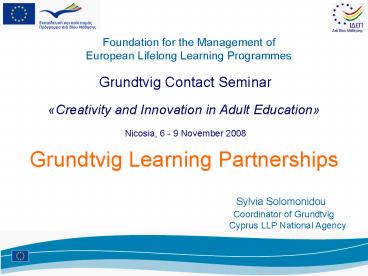Sylvia Solomonidou - PowerPoint PPT Presentation
1 / 18
Title:
Sylvia Solomonidou
Description:
Production and dissemination of information material or the co-operation activities ... Procedure to apply ... Eligibility check by national agencies ... – PowerPoint PPT presentation
Number of Views:55
Avg rating:3.0/5.0
Title: Sylvia Solomonidou
1
Foundation for the Management of European
Lifelong Learning Programmes Grundtvig Contact
Seminar Creativity and Innovation in Adult
Education
Nicosia, 6 - 9 November 2008
Grundtvig Learning Partnerships
Sylvia Solomonidou
Coordinator of Grundtvig
Cyprus LLP National Agency
2
What is a Grundtvig Learning Partnership?
(1/2)
- The Grundtvig Learning Partnership is a
framework for practical co-operation activities
between organisations working in the field of
adult learning in the broadest sense formal,
non-formal or informal. - In a Grundtvig Learning partnership staff and
learners work together on one or more topics of
common interest to the co-operating organisations
3
What is a Grundtvig Learning
Partnership? (2/2)
- A partnership consists of Adult Learning
Organisations located in at least three of the
countries participating in the Lifelong Learning
Programme. - (At least one participating institution is
located in a member state of the EU at the
starting date of the partnership).
4
Aims/Objectives of the partnerships
- Grundtvig Learning Partnerships contribute to
- an increased awareness of the varied European
cultural, social and economic scene - a better understanding of areas of common
interest in the field of adult learning
5
Focus of Learning Partnerships
- Partnerships can focus on
- the active participation of learners or,
- on management of adult education and/or teaching
methods
6
Activities of Learning Partnerships (1/2)
- The following activities may be supported
- Partner meetings and seminars between all
institutions involved in the Partnership - Exchanges of staff and adult learners involved in
project activities - Exchanges of experiences by using ICT
- Fieldwork, project research
- Preparation of performances (theatre plays,
musicals, etc.)
7
Activities of Learning Partnerships (2/2)
- Linguistic preparation for persons involved in
the partnership - Making of technical objects, drawings and arts
related to the project - Self evaluation activities
- Organisation of exhibitions
- Production and dissemination of information
material or the co-operation activities - Dissemination of project experience and outcomes
8
Call for proposals 2009-2011
- No European priorities
- National eligibility criteria and/or national
priorities in some countries
9
Duration 2 years Eligibility
period 01/08/2009 - 31/07/2011
Budgetary support for mobility and local project
costs. (Predefined lumpsums, based on a minimum
number of mobilities)
- Mobility action types based on minimum number of
mobilities - 4 mobilities
- 8 mobilities
- 12 mobilities
- 24 mobilities (out of which16 learners)
Mobility for staff and learners One mobility
means one trip (by one person) Grant amounts
vary from country to country
10
Outcomes/Results of a partnership
- They can be descriptive or tangible
- a CD-Rom,
- Video,
- a booklet, a leaflet
- a webpage
- Performances (theatre music, sport)
- Strategic / policy papers
- Art objects
11
How to start a project
- Agree with your partner institutions on the
topic/theme, expected results and final products
of project - Decide how the theme will be developed in each
participating institution - Decide which learning and/or other ongoing
activities at each institution are likely to be
involved either directly or indirectly - Choose the language of communication between
partner institutions
12
Setting up the project (1/2)
- Be clear and coherent in setting up a work plan
- Dont be over-ambitious
- Be flexible and open-minded
- Decide about the coordinating institution
- Decide which of the partners volunteer to act as
replacement coordinators - Decide about the final product(s)
13
Setting up the project (2/2)
- Plan the activities at each institution
- Plan the project meetings (transnational
mobility) - Plan the exchange of materials, products and
results - Decide about the methods of monitoring and
evaluation - Discuss about the dissemination of the outcomes/
end products
14
What makes a good partnership? A good
partnership
- is coordinated effectively
- promotes active and balanced involvement of all
members of the partnership - has clear objectives and realistic outcomes
- has a clear project calendar
- uses ICT effectively
- promotes equal opportunities
- plans for the ongoing evaluation
- plans for the use and dissemination of project
outcomes at local, regional, national level - has the full support of the management team of
the institution
15
Procedure to apply
- Each participating institution has to apply to
its own national agency using the 2009
application form - Each institution checks with its national agency
whether there are any national eligibility
criteria, national priorities and/or any other
additional information to be submitted in support
of the application - Each institution submits a copy of the
common/jointly completed application to its
national agency on paper (some national agencies
require electronic submission too) - Closing date for all countries 20 February 2009
16
Selection process
- Eligibility check by national agencies
- Quality assessment by experts under the
responsibility of the country of the coordinator - Matching / selection phase at European level
- By end of July 2009 selection decisions
- National Agencies send agreements to selected
applicants - Partnership starts 1st August 2009
- Partnership ends 31st July 2011
17
Tools for monitoring andself evaluation of
partnerships
- MICE a tool for self evaluation of projects
www.mice-t.net - QAS a tool for project support for quality and
sustainability http//qas.programkontoret.se - CAT a tool for how ICT can be used in
collaborative transnational projects
www.leargas-ie/cat - PROBENET a tool for self evaluation of
projects www.i-probenet.net
18
- Europe creates opportunities
- Your application is your ticket to funding
- GOOD LUCK































